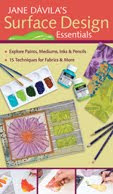Quilting Arts In Stitches blog tour
Thanks for visiting the last stop on the In Stitches Volume 5 blog tour! I am SO excited about this issue - there is an abundance of beautiful, intriguing, strong work and creative, innovative techniques.

One of the best parts of my job as editor is getting to know and to work with the artists in each issue. I am grateful to all of them for sharing their art and talent and time with all of us.
Some highlights from this issue:
Carol Ann Waugh has an interesting take on combining hand and machine stitching. I seriously want to explore the decorative stitches on my machine now! (Many thanks to my friend Vivien Zepf for telling about Carol and her work!)
Therese May shares her abundance quilts and inspires a challenge for our readers! Make sure you check it out - I think you'll be tempted to enter.
Barb Forrister makes the most beautiful, artistic three-dimensional flowers and her video is super informative. If you've never tried this, Barb is the perfect person to show you how.
Alma Stoller's fabric beads are fun and colorful and there are definitely some of these in my future too! I need to justify my bead-buying habit and her fabric beads are just the ticket.
Larkin Van Horn has inspired me to create a fabric reliquary. I'm thinking these embellished boxes would make fantastic containers for presents this holiday season as well as special containers for treasured items.
Cheryl Sleboda is on the cutting edge of technology as she introduces us to electroluminescent wire that lights up your quilts. You have to see this to believe it! There are light switches next to each of her quilts in the article so that you can see what the quilts look like with the wire on and off.
Amanda McCavour creates the most sublime drawings in thread using just thread. Seriously, only thread! They're suspended in air and are Line in its most pure form. And she's so appealing in her video - I just want to hang out with her in her studio!
I hope you check out this latest In Stitches for your Mac or PC.
I'm super excited to announce that it's now available for your iPad too! Just head to the App store and search for Interweave or Quilting Arts.
In case you missed any of the other stops on the blog tour, here's the complete line-up. I encourage you to see what else these talented artists are up to!
Monday 10/10 Lindsey Murray http://quiltingdaily.com
Tuesday 10/11 Larkin Van Horn http://blog.larkinart.com
Wednesday 10/12 Cheryl Sleboda http://blog.muppin.com
Thursday 10/13 Alma Stoller http://almastoller.blogspot.com
Friday 10/14 Therese May http://theresemay.blogspot.com
Monday 10/17 Barb Forrister http://barbforrister.com/category/blog
Tuesday 10/18 Carol Ann Waugh http://carolannwaugh.com/blog/
Wednesday 10/19 Jane Davila http://janedavila.blogspot.com
If you have an idea for In Stitches and would like to be in our emagazine, please visit the submissions page and send us your thoughts!












